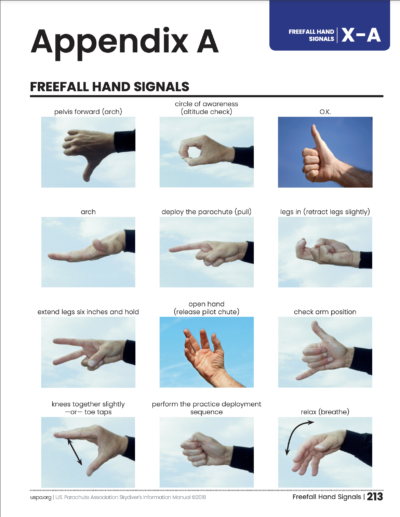Funny Hand Gestures While Sky Diving
Many sports use hand signals to communicate with their athletes and fans. Basketball, football, and soccer are mainstream sports that most anyone knows by heart as sports enthusiasts. But other sports like snow skiing, water sports, and skydiving also have hand signals that are less known – especially skydiving. In this article, we'll explore the many hand signals used in the sport of skydiving.
Why Skydiving Hand Signals
Unlike the popular movie Point Break with Patrick Swayze and Keanu Reeves skydiving scene with Bodhi calling out, "Fly like an eagle, Johnny!" is well – Hollywood fiction. When we skydive we're falling about 120 mph and the wind at that speed is loud where if you talk, you not only won't hear anyone, you'll just be spitting all over your face!
Hand signals are very important for instructors to communicate to student skydivers learning the craft. So what are they?
Freefall Hand Signals
There are a few important hand signals that guide students to correct the freefall body position for stability and progression. Because we cannot carry a conversation in freefall to give corrections, we use hand signals to communicate. Here are a few common ones (and note: this article doesn't cover all the necessary hand signals, however, is taught in every first solo jump course):
Arch
A curved body position with chin up, arms relaxed, hips down and legs extended at 45° is the foundation for control in freefall. However, it's a challenging position to achieve as our instincts are to curl up a ball in response to fight or flight! Therefore, instructors may use the ARCH signal to remind students to push their hips forward for the ideal arch.
Extend Legs
As we described, the ideal body position is chin up, arms relaxed, hips down and legs at a 45° angle. It is incredibly common that students do not "fly," feel, or utilize their legs. Why? We're not sure, we did it ourselves. To address this, an instructor will give the "extend leg" signal.
Check Arms
I bet you may already be going through the stable body position list… chin up, arms relaxed, hips down, and legs at 45° angle. Yup. Some students fly with their arms straight out, some fly a little uneven, and some may not have awareness of where their arms are at all. For this case, an instructor may give the "check arms" signal.

Wave Off
Later on in your progression, as you master stability and control, and then forever on as an experienced skydiver, you'll use the 'wave off' signal. This is taking both arms, crossing them creating an X shape, opening back to neutral, and repeating once more. This is the universal signal that you are about to open your parachute. This lets others on the skydive know to stay clear of your airspace. The United States Parachute Association, the governing body for skydiving, provides more hand signals for jumpers.
Parachute Signals
Once the parachute is open, the distance becomes so great between you and your instructor that you wouldn't be able to see them. Students are taught the skills necessary to check, steer and land the parachute, but wear radios for extra guidance back to earth. However, there are rare occasions in student training where an instructor may give hand signals to a student landing the parachute – but it isn't a reliable method.
Skydiving has come a long way – especially since a skydiving classic called, Fandango was produced in the '70s. In this film, a crew member writes a message in the desert to communicate to the skydiver about to jump!
Professional demonstration teams still use a method similar to Fandango but with bright, fabric panels that are pre-determined and communicated prior to the jump. The panels are shaped into an "=" for standby or an "x" for do not jump.
Want More Tips to Prepare to Skydive?
It's always nice to feel prepared, especially when embarking on such an epic adventure as skydiving! Here are a few great articles to keep you updated and prepped!
Coaching Tips to Help Every Skydiver
Ready to Skydive, What You Need to Know
Source: https://skydivemonroe.com/blog/skydiving-hand-signals-what-to-know/
0 Response to "Funny Hand Gestures While Sky Diving"
Postar um comentário